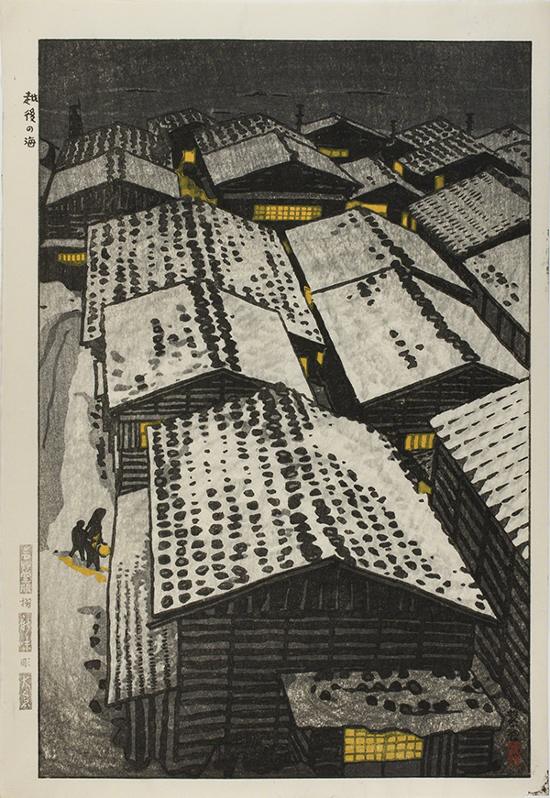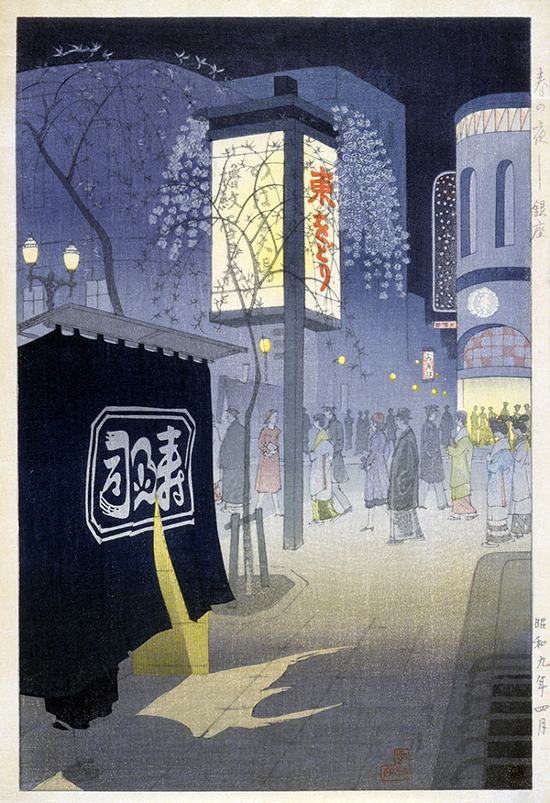Gem of the Month: Shirō Kasamatsu
Ukiyo-e was a woodblock print aesthetic that was popular from the late 1600s to the mid 1800s. The genre developed a visual vocabulary that documented the entertainments of Japanese urban centers, particularly that of Tokyo (known as Edo until 1868). Although the style waned in popularity by the late 1800s, it was revived by a new generation of artists during the first two decades of the 1900s. It has persisted in popularity internationally to the present day in the shin hanga and sōsaku hanga print genres. One particularly popular subject is the changes in the four seasons, a subject that also had an enduring popularity in traditional Japanese monochromatic painting. Shirō Kasamatsu was absolutely brilliant at eliciting the spirit of each season in his woodcut prints.
 |
| Shirō Kasamatsu (1898–1991, Japan), The Sea at Echigo, 1957. Color woodcut print on paper, 15 ⅞" x 10 ¾" (40.3 x 27.3 cm). Image courtesy of the Philadelphia Museum of Art. © 2024 Artist or Estate of Artist. (PMA-8155) |
Like his fellow shin hanga artist Hasui Kawase (1883–1957), Kasamatsu was an expert at night, rain, and snow scenes in the woodblock medium. There is an emphasis on ambient light and linear one-point perspective in this scene on the Sea of Japan. This is indicative of the strength of Western influence on Japanese woodblock print movements in the first half of the 1900s.
In this sōsaku hanga print, Kasamatsu demonstrates a sophisticated sense of bokashi (“blur”) shading. Bokashi is a technique of achieving different values of a color by an uneven application of color to the woodblock before printing. Sōsaku hanga artists applied gradations of color with a brush, whereas traditional ukiyo-e printers would rub away excess ink to create bokashi. Such hand manipulation of the ink had to be repeated with every sheet printed, and thus the nuances of color varied from print to print. Bokashi in this print is quite evident in the gradations of gray on the rooftops. A further difference from ukiyo-e prints is the less linear nature of Kasamatsu's print.
Although ukiyo-e persisted after the Edo period (1615–1868), particularly in landscape and cityscape prints, it had more or less run its course during the Meiji period (1868–1912). The two Japanese print movements shin hanga (“new print”) and sōsaku hanga (“creative print”) arose in the early 1900s. They were the result of efforts by a group of artists to resurrect the spirit of ukiyo-e.
Artists of the shin hanga movement, which flourished between 1915 and 1947, emphasized the traditional hierarchy of artist, woodblock carver, and publisher as separate entities in the process of producing prints. This was in contrast to the sōsaku hanga artists who made sketches, drew the design, cut the woodblock, and printed it themselves. Sōsaku hanga evolved as an idea in the 1890s and is sometimes assigned the “starting date” of 1904 with the publication of creative prints in Myojo magazine. As a genre, sōsaku hanga flourishes to the present day and is sometimes referred to as “New Hanga.” Both print movements reflect Western influence in style. Ironically, both shin hanga and sōsaku hanga prints had more appeal abroad than in Japan.
Kasamatsu is unique among Japanese printmakers of the early 1900s in that he was equally adept in the shin hanga and sōsaku hanga movements. He could trace his lineage back to the late-ukiyo-e artist Yositoshi Tsukioka (1839–1892). Born in Tokyo, at age 13 Kasamatsu attended the painting school of Kaburagi Kiyokata (1878–1972), an expert in traditional painting and a producer of bijin-ga (beautiful woman pictures) woodblock prints. Kiyokata's work suggests the influence of Western-style realism within traditional subject matter.
Around 1919, Kasamatsu began making designs for woodblock prints. Until the late 1950s, he worked exclusively in the shin hanga process in which his designs were translated to woodblock by professional carvers. After about 1955, Kasamatsu began producing prints in the sōsaku hanga process, even though it ended up being less lucrative than professionally published shin hanga works.
 |
| Shirō Kasamatsu, Spring Night, Ginza, 1934. Color woodcut on paper, 15 11⁄16" x 10 ¼" (39.9 x 26 cm). Image courtesy of Worcester Art Museum, Worcester, MA. © 2024 Artist or Estate of Artist. (WAM-630) |
This misty view of Tokyo’s famous shopping district is a brilliant example of Kasamatsu’s ability to capture gradations of color using the bokashi shading technique. It is also an interesting contrast in new and old—the new look of rapidly industrialized and built-up Tokyo and the old-timey medium that harkens back to the ukiyo-e style. Kasamatsu brilliantly captures the same affection for the city and its culture as did artists such as Hiroshige (1797–1858).
Correlations to Davis programs: Explorations in Art 2E Grade 1: 2.8; Explorations in Art 2E Grade 3: 4.1; Explorations in Art 2E Grade 4: 3.9; A Community Connection 2E, 4.5; Experience Printmaking: chapter 4; The Visual Experience 4E: 8.6

Comments